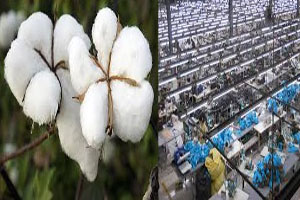
Myanmar cotton demand likely to rise with reopening of textile plants
YarnsandFibers News Bureau 2017-09-27 12:00:00 – YangonMyanmar government textile factories which were mostly stopped in the previous year as cotton production declined due to heavy rains in July, August and November. This year with the re-opening of the government textile factories, the demand for cotton is expected to rise and production likely to double, according to traders.
Since the start of the cotton production season, which runs from July to September, the government-owned factories and private factories ordered up to 3 million viss. Traders sold out all their stock. The production was 12 million viss for the year. If the weather is good, this year’s production will reach 30 million viss.
The textile factories administered by the Ministry of Industry placed their orders, which also increased the cotton price to K3600 a viss (about 1.6 kg a viss).
The Myanmar Cotton and Cotton Products Merchants and Manufacturers Association’s secretary U Aung Myint expects the demand to increase till the end of the season. Myanmar’s cotton production, one of Myanmar’s national strategic export crops, which usually takes place from July to March, faced difficulties accessing seeds.
The cultivation season is already over, so negotiations with the agriculture department will begin. However, they need to wait to see the weather in October.
The issue comes from Lunn Kyaw from Kyaukse township and Shwe Taung from Wandwin township’s difficulties to provide seeds for cotton plantation and long-term crops.
In Myanmar, there were 752,145 acres of cotton plantation for the 2014-2015 fiscal years; 720,662 acres for the 2015-2016 fiscal years; and 768,286 acres for the 2016-2017 fiscal years.
As cotton is part of the national export strategy, and the textile and garment industry is also a top priority, local raw material is expected to be on high demand.
Beside domestic use, cotton is also exported to China through border trade. It totalled 1.6 tonnes (US$3.5 million) in 2013-2014, and increased to 487.5 tonnes ($1.073 million) so far in the 2017-2018 fiscal year.
U Aung So director general of the Myanmar Trade Promotion under Ministry of Commerce said that half of the production goes to China, the rest answers local demand from textile factories.
The cotton association faces several challenges, such as the difficulty to access quality seeds and the lack of labour force. The association currently plans to relocate to Nay Pyi Taw.
Daw Tin Tin Shwe, general manager of the Panda Textile factory in Paleik city said that her factory purchased about 800 to 1000 tonnes of A-grade cotton during fiscal year 2016-2017. And this year, the factory is expected to buy more than that amount if there is no disruption of their production due to labour protest.
Many textile factories in Myanmar are now turning to locally produced cotton instead of procuring from abroad.
Market Intelligence
Ask for free sample Report

experience
Customer Base
dedicated team
Countries Served Worldwide









